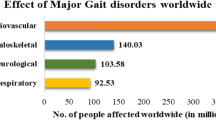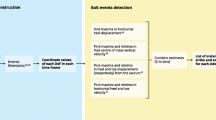Abstract
Knee osteoarthritis (KOA) is a progressive degenerative joint disease. This degenerative process leads to an alteration in the gait mechanics. There are varieties of methods that can be used to evaluate these gait differences. The purpose of this review is to critically analyze the research findings and to outline strategies for evaluating gait anomalies in KOA, including observational, vision-based, and sensor-based and hybrid gait assessment technologies. The gait analysis, carried out by these methods, enables the implementation of procedures suited to patients’ particular need is discussed. In all indices, the advantages and drawbacks of the available tools will be addressed after a concise description of the methods and the implementations in the KOA patients. The quantitative methods, categorized as vision, sensor-based, and hybrid technologies, have features that make them powerful and competitive for various types of requirements. Among these technologies, hybrid technology seems to be the most reliable and accurate because it can assess all aspects of gait assessment. Future studies should be done to develop a KOA gait dataset available publicly, consider all severity levels and all compartment KOA.

Adapted from Muro-de-la-Herran A, García-Zapirain B, Méndez-Zorrilla A. 2014 [16]

Adapted from Tarniţǎ D, Catanǎ M, Tarniţǎ DN. 2013 [31]

Adapted from Muro-de-la-Herran A, García-Zapirain B, Méndez-Zorrilla A. 2014 [16]

Adapted from Spinoso DH, Bellei NC, Marques NR, Navega MT. 2018 [33]

Adapted from Kiss RM. 2011 [34]

Adapted from BTS GAITLAB | Integrated Gait Analysis Systems | BTS Bioengineering. [36]
Similar content being viewed by others
Data Availability
All data generated or analyzed during this study are included in this published article.
Code Availability
Not applicable.
Abbreviations
- KOA:
-
Knee osteoarthritis
- OGA:
-
Observational gait analysis
- 3D:
-
3 Dimensional
- ICC:
-
Intraclass correlation coefficient
- IDEEA:
-
Intelligent Device for Energy Expenditure and Activity
- EMG:
-
Electromyography
References
Cui A, Li H, Wang D, Zhong J, Chen Y, Lu H. Global, regional prevalence, incidence and risk factors of knee osteoarthritis in population-based studies. EClinicalMedicine. 2020;29–30:100587. https://doi.org/10.1016/j.eclinm.2020.100587.
Pal CP, Singh P, Chaturvedi S, Pruthi KK, Vij A. Epidemiology of knee osteoarthritis in India and related factors. Indian J Orthopaedic. 2016;50(5):518–22. Available from: /pmc/articles/PMC5017174/?report=abstract
Favre J, Jolles BM. Gait analysis of patients with knee osteoarthritis highlights a pathological mechanical pathway and provides a basis for therapeutic interventions. EFORT Open Rev. 2016;1(10):368–74.
Taş S, Güneri S, Kaymak B, Erden Z. A comparison of results of 3-dimensional gait analysis and observational gait analysis in patients with knee osteoarthritis. Acta Orthop Traumatol Turc. 2015;49(2):151–9.
Ishikawa Y, An Q, Nakagawa J, Oka H, Yasui T, Tojima M, et al. Gait analysis of patients with knee osteoarthritis by using elevation angle: confirmation of the planar law and analysis of angular difference in the approximate plane. Adv Robot. 2017;31(1–2):68–79.
Sun J, Liu Y, Yan S, Cao G, Wang S, Lester DK, et al. Clinical gait evaluation of patients with knee osteoarthritis. Gait Posture. 2017;58:319–24. https://doi.org/10.1016/j.gaitpost.2017.08.009.
Kour N, Gupta S, Arora S. A survey of knee osteoarthritis assessment based on gait. Arch Comput Methods Eng. 2020;20:1–41. https://doi.org/10.1007/s11831-019-09379-z.
Clinical GAIT & Biomechanics | Life Sciences | Motion Capture Systems [Internet]. Available from: https://www.vicon.com/applications/life-sciences/gait-analysis-neuroscience-and-motor-control/. [Accessed 6 Oct 2020].
Qualisys | Motion Capture Systems [Internet]. Available from: https://www.qualisys.com/. [Accessed 6 Oct 2020].
Kinect - hardware [Internet]. Available from: https://developer.microsoft.com/en-gb/windows/kinect/. [Accessed 6 Oct 2020].
Cui X, Zhao Z, Ma C, Chen F, Liao H. A gait character analyzing system for osteoarthritis pre-diagnosis using RGB-D camera and supervised classifier. World Congress Med Phys Biomed Eng, Springer Singapore. 2019;297–301. https://doi.org/10.1007/978-981-10-9035-6_10
Deluzio KJ, Astephen JL. Biomechanical features of gait waveform data associated with knee osteoarthritis. An application of principal component analysis. Gait Posture. 2007;25(1):86–93.
Federolf PA, Boyer KA, Andriacchi TP. Application of principal component analysis in clinical gait research: identification of systematic differences between healthy and medial knee-osteoarthritic gait. J Biomech. 2013;46(13):2173–8. https://doi.org/10.1016/j.jbiomech.2013.06.032.
Phinyomark A, Osis ST, Hettinga BA, Kobsar D, Ferber R. Gender differences in gait kinematics for patients with knee osteoarthritis. BMC Musculoskelet Disord. 2016;17(1):1–12. https://doi.org/10.1186/s12891-016-1013-z.
Akhtaruzzaman MD, Shafie AA, Khan MR. Gait analysis: systems, technologies, and importance. J Mech Med Biol. 2016;16(7):1630003. https://doi.org/10.1142/S0219519416300039.
Muro-de-la-Herran A, García-Zapirain B, Méndez-Zorrilla A. Gait analysis methods: an overview of wearable and non-wearable systems, highlighting clinical applications. Sensors (Switzerland). 2014;14(2):3362–94.
Kotti M, Duffell LD, Faisal AA, McGregor AH. Detecting knee osteoarthritis and its discriminating parameters using random forests. Med Eng Phys. 2017;43:19–29. https://doi.org/10.1016/j.medengphy.2017.02.004.
GAITRite | Temporospatial Gait Analysis [Internet]. Available from: https://www.gaitrite.com/. [Accessed 6 Oct 2020].
Menz HB, Latt MD, Tiedemann A, Kwan MMS, Lord SR. Reliability of the GAITRite® walkway system for the quantification of temporo-spatial parameters of gait in young and older people. Gait Posture. 2004;20(1):20–5.
Peixoto JG, de Souza MB, Diz JBM, Timoteo EF, Kirkwood RN, Teixeira-Salmela LF. Analysis of symmetry between lower limbs during gait of older women with bilateral knee osteoarthritis. Aging Clin Exp Res. 2019;31(1):67–73. https://doi.org/10.1007/s40520-018-0942-9.
Wiik AV, Aqil A, Brevadt M, Jones G, Cobb J. Abnormal ground reaction forces lead to a general decline in gait speed in knee osteoarthritis patients. World J Orthop. 2017;8(4):322–8.
Tarniţă D. Wearable sensors used for human gait analysis. Rom J Morphol Embryol. 2016;57(2):373–82.
Staab W, Hottowitz R, Sohns C, Sohns JM, Gilbert F, Menke J, et al. Accelerometer and gyroscope based gait analysis using spectral analysis of patients with osteoarthritis of the knee. J Phys Ther Sci. 2014;26(7):997–1002.
Hafer JF, Provenzano SG, Kern KL, Agresta CE, Grant JA, Zernicke RF. Measuring markers of aging and knee osteoarthritis gait using inertial measurement units. J Biomech. 2020;99:109567. https://doi.org/10.1016/j.jbiomech.2019.109567.
Tereso A, Martins MM, Santos CP. Evaluation of gait performance of knee osteoarthritis patients after total knee arthroplasty with different assistive devices. Res Biomed Eng. 2015;31(3):208–17.
Bolink SAAN, Van Laarhoven SN, Lipperts M, Heyligers IC, Grimm B. Inertial sensor motion analysis of gait, sit-stand transfers and step-up transfers: differentiating knee patients from healthy controls. Physiol Meas. 2012;33(11):1947–58.
MiniSun_IDEEA [Internet]. Available from: http://www.minisun.com/paa.htm. [Accessed 6 Oct 2020].
Barden JM, Clermont CA, Kobsar D, Beauchet O. Accelerometer-based step regularity is lower in older adults with bilateral knee osteoarthritis. Front Hum Neurosci. 2016;10(DEC2016):1–9.
Hubley-Kozey C, Deluzio K, Dunbar M. Muscle co-activation patterns during walking in those with severe knee osteoarthritis. Clin Biomech. 2008;23(1):71–80.
Tao W, Liu T, Zheng R, Feng H. Gait analysis using wearable sensors. Sensors. 2012;12(2):2255–83.
Tarniţǎ D, Catanǎ M, Tarniţǎ DN. Experimental measurement of flexion-extension movement in normal and osteoarthritic human knee. Rom J Morphol Embryol. 2013;54(2):309–13.
Muñoz-Organero M, Littlewood C, Parker J, Powell L, Grindell C, Mawson S. Identification of walking strategies of people with osteoarthritis of the knee using insole pressure sensors. IEEE Sens J. 2017;17(12):3909–20.
Spinoso DH, Bellei NC, Marques NR, Navega MT. Quadriceps muscle weakness influences the gait pattern in women with knee osteoarthritis. Adv Rheumatol (London, England). 2018;58(1):26.
Kiss RM. Effect of severity of knee osteoarthritis on the variability of gait parameters. J Electromyogr Kinesiol. 2011;21(5):695–703.
Cimolin V, Galli M. Summary measures for clinical gait analysis: a literature review. Gait Posture. 2014;39(4):1005–10. https://doi.org/10.1016/j.gaitpost.2014.02.001.
BTS GAITLAB | Integrated Gait Analysis Systems | BTS Bioengineering [Internet]. Available from: https://www.btsbioengineering.com/products/bts-gaitlab-gait-analysis/. [Accessed 6 Oct 2020].
Fukaya T, Mutsuzaki H, Mori K. Influence of pain on knee joint movement and moment during the stance phase in patients with severe bilateral knee osteoarthritis: a pilot study. Medicina. 2019;55(12):1–7.
Robbins SM, Morelli M, Martineau PA, St-Onge N, Boily M, Dimentberg R, et al. A comparison of muscle activation and knee mechanics during gait between patients with non-traumatic and post-traumatic knee osteoarthritis. Osteoarthr Cartil. 2019;27(7):1033–42. https://doi.org/10.1016/j.joca.2019.02.798.
Nie Y, Wang H, Xu B, Zhou Z, Shen B, Pei F. The relationship between knee adduction moment and knee osteoarthritis symptoms according to static alignment and pelvic drop. Biomed Res Int. 2019;2019(8):7603249. https://doi.org/10.1155/2019/7603249.
Baker M, Stanish W, Rutherford D. Walking challenges in moderate knee osteoarthritis: a biomechanical and neuromuscular response to medial walkway surface translations. Hum Mov Sci. 2019;68:102542. https://doi.org/10.1016/j.humov.2019.102542.
Meireles S, Wesseling M, Smith CR, Thelen DG, Verschueren S, Jonkers I. Medial knee loading is altered in subjects with early osteoarthritis during gait but not during step-up-and-over task. PLoS One. 2017;12(11):1–20.
Rutherford D, Baker M, Wong I, Stanish W. The effect of age and knee osteoarthritis on muscle activation patterns and knee joint biomechanics during dual belt treadmill gait. J Electromyogr Kinesiol. 2017;34:58–64. https://doi.org/10.1016/j.jelekin.2017.04.001.
Resende RA, Kirkwood RN, Deluzio KJ, Morton AM, Fonseca ST. Mild leg length discrepancy affects lower limbs, pelvis and trunk biomechanics of individuals with knee osteoarthritis during gait. Clin Biomech. 2016;38:1–7.
Farrokhi S, O’Connell M, Gil AB, Sparto PJ, Fitzgerald GK. Altered gait characteristics in individuals with knee osteoarthritis and self-reported knee instability. J Orthop Sports Phys Ther. 2015;45(5):351–9.
Chang AH, Moisio KC, Chmiel JS, Eckstein F, Guermazi A, Prasad PV, et al. External knee adduction and flexion moments during gait and medial tibiofemoral disease progression in knee osteoarthritis. Osteoarthr Cartil. 2015;23(7):1099–106. https://doi.org/10.1016/j.joca.2015.02.005.
Rutherford DJ, Hubley-Kozey CL, Stanish WD. Changes in knee joint muscle activation patterns during walking associated with increased structural severity in knee osteoarthritis. J Electromyogr Kinesiol. 2013;23(3):704–11. https://doi.org/10.1016/j.jelekin.2013.01.003.
Bechard DJ, Birmingham TB, Zecevic AA, Jones IC, Giffin JR, Jenkyn TR. Toe-out, lateral trunk lean, and pelvic obliquity during prolonged walking in patients with medial compartment knee osteoarthritis and healthy controls. Arthritis Care Res. 2012;64(4):525–32.
Astephen Wilson JL, Deluzio KJ, Dunbar MJ, Caldwell GE, Hubley-Kozey CL. The association between knee joint biomechanics and neuromuscular control and moderate knee osteoarthritis radiographic and pain severity. Osteoarthr Cartil. 2011;19(2):186–93. https://doi.org/10.1016/j.joca.2010.10.020.
Liikavainio T, Bragge T, Hakkarainen M, Karjalainen PA, Arokoski JP. Gait and muscle activation changes in men with knee osteoarthritis. Knee. 2010;17(1):69–76. https://doi.org/10.1016/j.knee.2009.05.003.
Rutherford DJ, Baker M. Knee moment outcomes using inverse dynamics and the cross product function in moderate knee osteoarthritis gait: a comparison study. J Biomech. 2018;10(78):150–4.
Author information
Authors and Affiliations
Contributions
Conceptualization: PC and ZV; writing—original draft: PC; writing—review and editing: PC, ZV, ZK, TT, Iram, MA. All authors read and approved the final manuscript.
Corresponding author
Ethics declarations
Ethics Approval and Consent to Participate
Not applicable.
Consent for Publication
Not applicable.
Competing Interests
The authors declare no competing interests.
Additional information
Publisher's Note
Springer Nature remains neutral with regard to jurisdictional claims in published maps and institutional affiliations.
Rights and permissions
Springer Nature or its licensor (e.g. a society or other partner) holds exclusive rights to this article under a publishing agreement with the author(s) or other rightsholder(s); author self-archiving of the accepted manuscript version of this article is solely governed by the terms of such publishing agreement and applicable law.
About this article
Cite this article
Choursiya, P., Veqar, Z., Khan, Z. et al. Gait Analysis Technologies for Measurement of Biomechanical Parameters of Knee Osteoarthritis. SN Compr. Clin. Med. 6, 6 (2024). https://doi.org/10.1007/s42399-023-01635-5
Accepted:
Published:
DOI: https://doi.org/10.1007/s42399-023-01635-5




